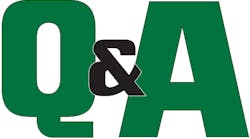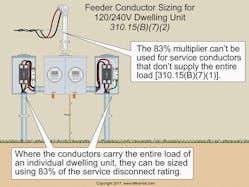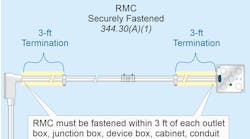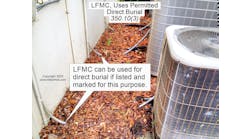All questions and answers are based on the 2017 NEC.
Underlined text indicates a change in the rules for the 2017 NEC.
Q. What is the Code rule for sizing service conductors for dwellings?
A. For dwelling units, service and feeder conductors supplied by a single-phase, 120/240V and 120/208V system can be sized in accordance with the requirements contained in Sec. 310.15(B)(7)(1) through (3).
(1) Service Conductors. Ungrounded service conductors not over 400A supplying the entire load of a one-family dwelling or an individual dwelling unit in a two-family or multifamily dwelling can have the conductor ampacity sized to 83% of the service overcurrent protection device rating.
Size feeder conductors based on the requirements outlined in Sec. 310.15(B)(7)(2).
Example: What size service conductors are required if the calculated load for a dwelling unit equals 195A, and the service disconnect is rated 200A?
Solution: Use Sec. 240.4(B) and Sec. 240.6(A) to determine service overcurrent protection rating. A 195A load requires a 200A rated circuit breaker.
200A rated circuit breaker multiplied by 83% = 166A
A 2/0 AWG service conductor is rated 175A at 75°C [Table 310.15(B)(16)] so this size conductor will work in this situation.
Section 310.15(B)(7) can’t be used for service conductors for two-family or multifamily dwelling buildings.
(2) Feeder Conductors. Ungrounded feeder conductors not over 400A supplying the entire load of a one-family dwelling, or an individual dwelling unit in a two-family or multifamily dwelling, can have the ungrounded feeder conductors sized to 83% of the feeder overcurrent protection device rating (Figure).
Section 310.15(B)(7)(2) can’t be used to size feeder conductors where a feeder doesn’t carry the entire load of the dwelling unit.
Example: What size feeder conductors are required if the calculated load for a dwelling unit equals 195A, the service disconnect is rated 200A, and the feeder conductors carry the entire load of the dwelling unit?
Solution: A 200A rated circuit breaker multiplied by 83% = 166A
A 2/0 AWG feeder conductor is rated 175A at 75°C [Table 310.15(B)(16)] so this size conductor will work in this situation.
(3) Feeder Conductors Not Greater Than. Feeder conductors for an individual dwelling unit aren’t required to be larger than the service conductors.
(4) Neutral Conductors. For one-family dwellings and individual dwelling units of two-family and multifamily dwellings, service and feeder neutral conductors supplied by a single-phase, 120/240V system can be smaller than the ungrounded conductors, if the requirements of Sec. 220.61 and Sec. 230.42 for services and Sec. 220.61 and Sec. 215.2 for feeders are met.
Caution: Because the service neutral conductor is required to serve as the effective ground-fault current path, it must also be sized so it can safely carry the maximum fault current likely to be imposed on it [110.10 and 250.4(A)(5)]. This is accomplished by sizing the neutral conductor in accordance with Table 250.102(C), based on the area of the largest ungrounded service conductor [250.24(C)].
Example: What size neutral conductor is required if the calculated load for a dwelling unit equals 195A, the maximum unbalanced load is 100A, and the service disconnect is rated 200A with 2/0 AWG ungrounded service conductors?
Answer: A 3 AWG neutral conductor is required because it’s rated 100A at 75°C in accordance with Table 310.15(B)(16), and 310.15(B)(7)(3). Also, Sec. 250.24(C) requires the neutral conductor to be sized no smaller than 4 AWG based on 2/0 AWG service conductors in accordance with Table 250.102(C).
Where conductor ampacity correction or adjustment factors are required by Sec. 310.15(B)(2) or (3), we can use the ampacity associated with the temperature rating of the conductor in accordance with Table 310.15(B)(16) as the basis for adjustment or correction.
Informational Note 1: The service or feeder ratings addressed by this section are based on the standard ampacity ratings from 240.6(A).
These materials are provided to us by Mike Holt Enterprises in Leesburg, Fla. To view Code training materials offered by this company, visit www.mikeholt.com/code






